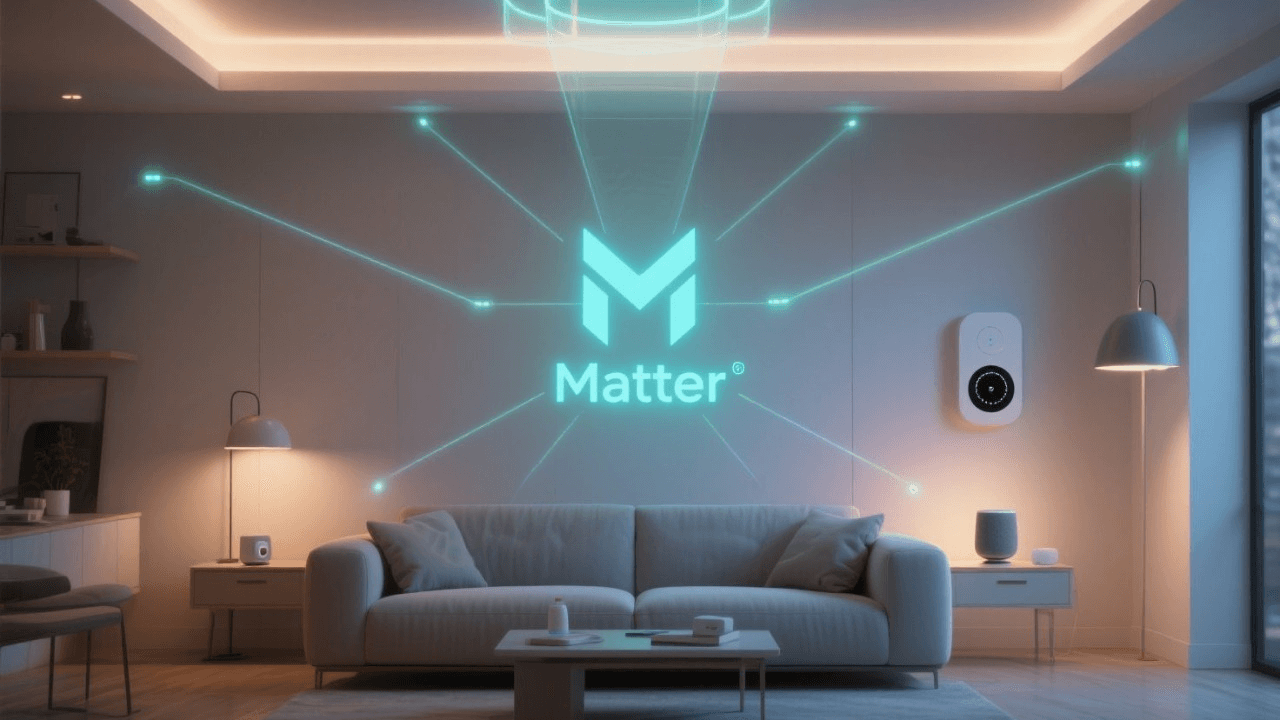What is Matter? The Ultimate Guide to Finally Making Your Smart Home Work
Sick of Smart Devices That Don’t Talk to Each Other? You’re Not Alone.
If you’re wondering what is Matter and why it’s the biggest buzz in tech, you’re not alone. For years, smart devices have ignored each other like rival high school cliques, and many of us are losing our minds over it.

Take this: You splurge on a fancy Philips Hue bulb, dreaming about smooth James Bond moods at the tap of your phone. Next thing you know, you spot a cheap TP-Link smart plug, toss it into the cart (because why not, right?), only to realize it speaks a totally different language than the bulb. Oh, and someone thinks they’re helping by giving you an Amazon Echo for your birthday. Nice, except now your phone is basically a graveyard of clashing apps you barely remember downloading.
Seriously, just asking your house to “turn on the living room lights” turns into an exercise in futility. You’re playing tech support in your own home, wondering if it’s all worth it or if you should just invest in candles and be done with it.
The “smart” home has been a mess for years. Everyone wants things that just work, but the reality has been more like a reality show. Apple wants you in its club, Google has its own ecosystem, and Amazon is all about “play with me or get out.” Trying to mix things up? Good luck. It’s like trying to force your cat and dog to share a bed—all you’re left with is hissing and bitter disappointment.
But what if there was a common language that all your gadgets spoke? No more territorial disputes, no more “Sorry, this doesn’t work with your system.” Turns out, this isn’t science fiction anymore. There’s a new technology standard on the market that could finally solve this mess. It’s called Matter, and honestly, it’s probably the most exciting thing to happen to smart homes since… well, forever.
So, What is Matter? A Simple Explanation
No nerd talk here. I’ll explain it in two easy ways:
Analogy 1: Matter is the USB-C for your smart home.
Okay, remember when every piece of tech needed its own weird, random charger? That graveyard of mystery cords hiding in your kitchen drawer… classic. Your old Nokia brick had one chunky plug, your camera had another, and your MP3 player? Total chaos. Enter USB-C, the superhero of charging. Suddenly, you’re living the good life with a single cable running the show for phones, laptops, and headphones. It just works. Matter is doing that same magical trick, except for all the wireless stuff lighting up your smart home.
Analogy 2: Matter is the ultimate universal translator.
Here’s the deal: your Google Nest is basically speaking Martian, your Apple HomePod’s babbling in Venusian, and your Amazon Echo? Who knows—maybe it’s mumbling in Klingon. They don’t get each other. Matter steps in, and suddenly your tech can actually understand each other, talk things out, and maybe even get along.
In short, Matter is an open-source connectivity standard—fancy lingo for “everybody finally agreed on something.” We’re talking a mega-collaboration here: the big dogs (Apple, Google, Amazon), plus Samsung, Philips Hue, Nanoleaf, and basically anyone who makes smart devices. The goal? End the endless “my device, my rules” nonsense and build one safe, stable smart home platform that actually makes life easier. For once.
Watch this short video from the tech experts at “6 Months Later” for a great visual explanation of what you’ll need to get started:
How Does It Actually Work? (A Peek Under the Hood)
So how does Matter pull this off? It’s not just buzzwords; it’s clever tech. Before Matter, every gadget spoke its own weird language: Wi-Fi, Bluetooth, Zigbee, Z-Wave… like a room full of people yelling different dialects and getting nowhere. Matter rolls up and says, “Everybody chill, we’re building one big road that actually goes somewhere.”
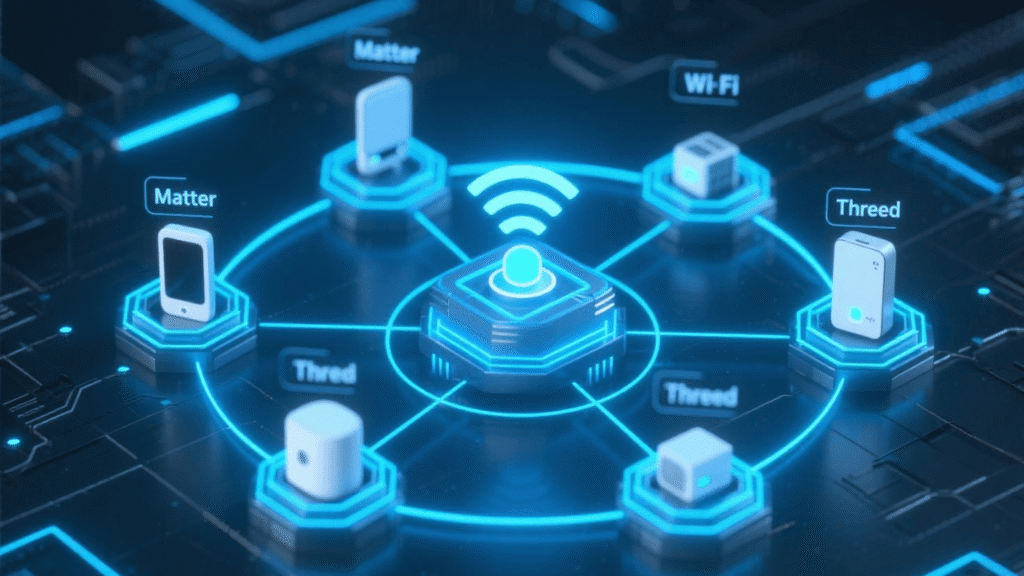
It primarily uses two key technologies:
- Thread: Picture a network of quiet, efficient back roads that only your smart devices know. That’s Thread—a low-power mesh network that links up all your smaller gizmos (bulbs, sensors, etc.). If one little smart bulb dies, no biggie—the signal just wiggles around it and keeps cruising. Think of it as a spiderweb for your gadgets, making the network super reliable.
- Wi-Fi: You already know this one. Wi-Fi’s the eight-lane superhighway. Matter uses Wi-Fi when you’re doing heavy lifting, like streaming high-quality video from your security cameras.
Matter intelligently juggles both. A command might zip over Wi-Fi to your home hub, and then—bam—it takes a shortcut on the Thread network to zap your smart plug. The whole thing is faster than your cat knocking a glass off the counter.
Why Should You Care About Matter? The 4 Big Benefits
1. True Interoperability: Pick Whatever Gadget You Actually Want
Honestly, this is the main event. You’re not stuck in some company’s walled garden anymore. Want those slick-looking Nanoleaf panels but swear by Google Home? Go for it. Fell in love with an Eve sensor but, oops, you’re team Android? It’ll play nice anyway. You get to chase whatever’s coolest, cheapest, or just makes your nerdy heart flutter, no matter whose logo is stamped on it. This isn’t just empty talk; the whole industry is on board. Just peep that monster list of members on the official Connectivity Standards Alliance website.
2. Setup Without the Meltdown: No More App Nightmares
Setting up new smart gear used to be straight-up pain. You’d download another weird off-brand app, create yet another account (with a password you’ll forget in ten seconds), and then cross your fingers the thing even worked. With Matter? Way smoother. Basically, here’s how it goes: rip open the box, fire up whatever smart home app you’re loyal to, and scan the Matter QR code with your phone. That’s pretty much it. Your main app spots the new gadget and brings it into the squad. Real plug-and-play, not just a marketing promise this time.
3. Increased Reliability and Speed (Thanks to Local Control)
Ever had your smart lights go on strike because your internet took a nap? That’s old-school tech for you—commands had to hitchhike all the way to a server in the cloud and back just to flip a light switch two feet away. It makes zero sense. Matter keeps it all in the house. Your phone talks straight to your gadget over the local network, no global road trip required. The result? Super quick response, like blink-and-it’s-on fast. And if your Wi-Fi croaks, your basic smart home stuff keeps chugging along.
4. A Secure and Future-Proof Home
Security? Matter went all-in. We’re talking serious encryption on everything, and the standardized setup process actually patches up those dumb security gaps old devices had. Plus, since basically every tech giant is behind Matter, it’s not going anywhere. Buying Matter-certified gear is like future-proofing your house—your expensive toys will keep playing nice with whatever new tech comes next.
How to Get Started with Matter: A Practical 3-Step Guide
Step 1: Get a “Matter Controller” (Odds Are, You Already Have One)
First up—the Matter controller. People call it a “hub” or “border router,” but basically, it’s the boss of your smart home. It’s the over-caffeinated manager running the show and connecting your gadgets to the internet. The funny thing is, you probably already own one. Loads of popular devices were quietly updated to handle Matter in the background. We’re talking:
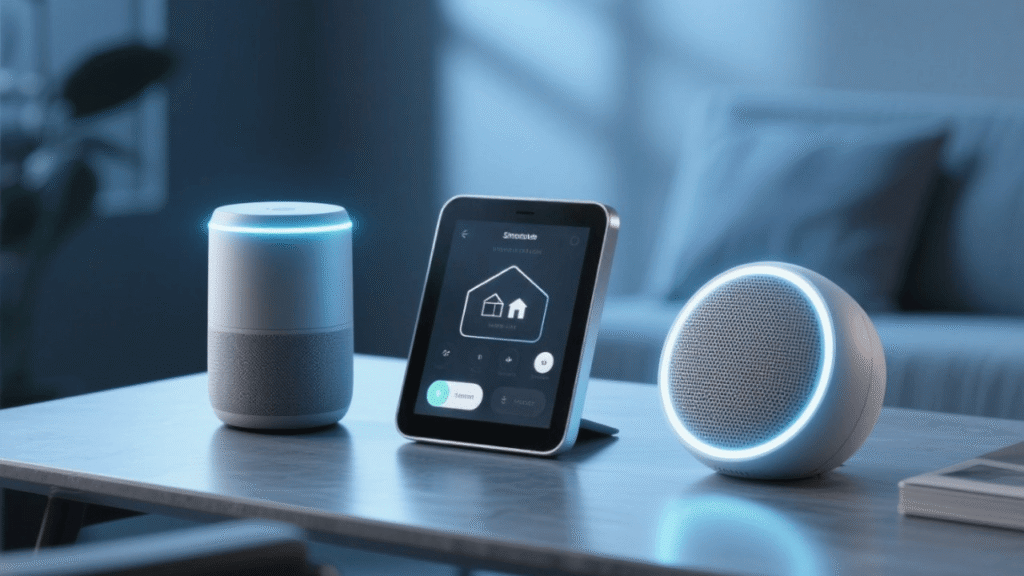
- Most recent Google Nest Hub or Nest Wifi devices.
- Amazon Echo speakers or displays (4th gen or newer).
- The Apple TV 4K, HomePod, or HomePod Mini.
- Samsung SmartThings Hubs (version 3 or newer).
You only need one of these to start. No need to panic-buy some futuristic glowing cube. Unless you want to. Your call.
Step 2: Just Find the Matter Logo
This bit is easy. Whenever you’re hunting for smart plugs, bulbs, or locks, just scan the box or the website for that Matter logo. It looks like a trippy little knot. If you see it, you’re golden. That symbol is basically your “hey, this thing just works” badge. No asterisks, no fine print.
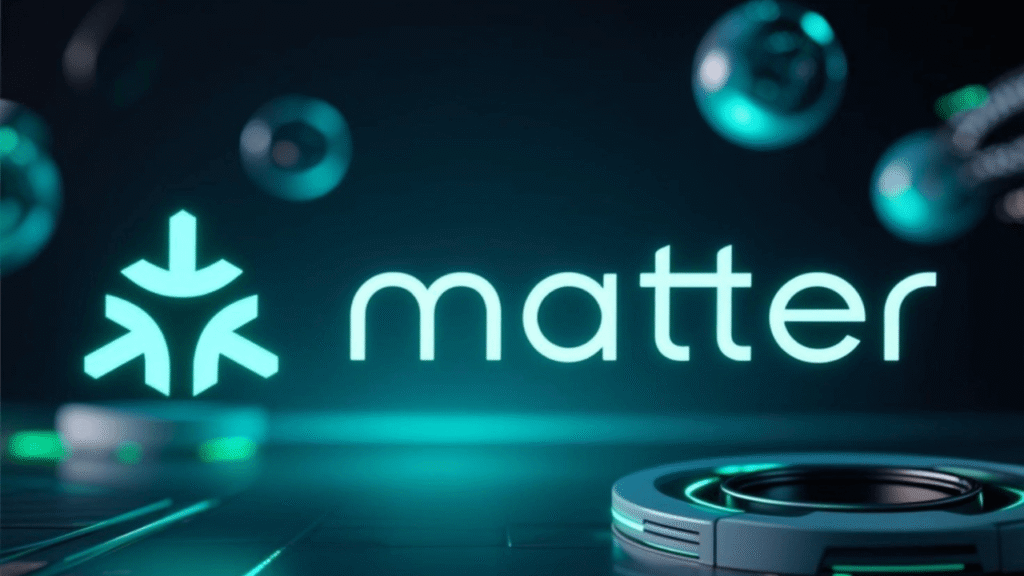
Step 3: Connect It All in Your Favorite App
Alright, so you’ve got your Matter-certified device and your controller. Next move: just crack open your usual smart home app—Google Home, Apple Home, Alexa, whatever’s on your phone. These apps will walk you through it. Usually, it’s as glamorous as scanning a QR code. In about 30 seconds, boom—it shows up, ready to use.
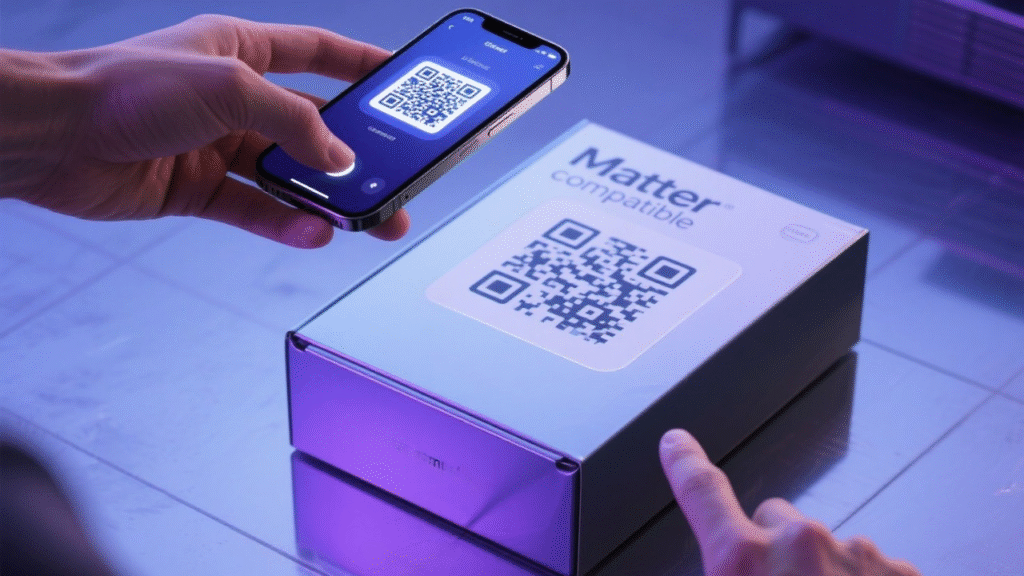
The Bottom Line: Is Matter the Dream? Or Nah?
Alright, time for some real talk. Matter is cool, but don’t toss your entire mountain of old smart devices just yet. We’re still in the early days. The main catch is device support—your lights, sensors, and plugs are sorted. But super fancy stuff like security cameras and robot vacuums? They’re still waiting for the patch. So for now, you might still have to juggle a couple of apps for your weirder gadgets. But the groundwork is in, and more device types get added every few months. The future’s cooking; it’s just not fully plated yet.
Read Next:
- (Coming Soon) The 5 Best Matter-Certified Smart Plugs in 2025
- (Coming Soon) How to Choose Your First Smart Home Hub
But after explaining what is Matter, is it the real deal? Yes. Unquestionably.
Matter is the most significant step forward for the smart home since its inception. This push towards unified standards is happening everywhere in tech. Just as powerful AI platforms like OpenAI’s Sora are revolutionizing video creation by providing a single, powerful tool for a complex task, Matter is set to do the same for our homes. The future isn’t just smart; it’s finally simple.

